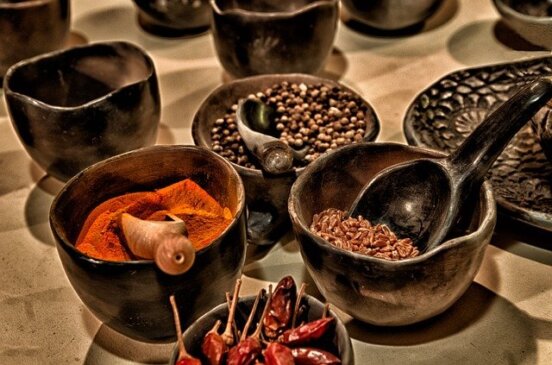Ayurveda means the science of life. With its roots in the Indian subcontinent, Ayurveda originated more than 5,000 years ago. It mainly emphasizes maintaining the balance in one’s life by the way of diet, lifestyle and right thinking. Here is a list of the top 10 Ayurvedic herbs and spices to include in your diet along with their health benefits that would help you maintain balance in your life:
1. Brahmi
Brahmi is one of the most well known ayurvedic herbs that is known as ‘brain tonic’ and ‘herb of grace’. It improves the intellect and power of the brain. It is also known to help asthmatic patients breathe better. Another interesting is that it can help open up the pineal gland that is associated with intuition. Most ayurvedic supplements contain brahmi in them.
How to consume: Brahmi can be taken either in supplement form, powder form or as juice.
2. Cardamom
Cardamom is an aromatic spice that is called the ‘queen of spices. It contains high levels of anti-oxidants, thus helpful in lowering high blood pressure. It is also known to have the ability to treat bad breath and prevent cavities. Also, it helps relieve stomach related issues like ulcers.
How to consume: Cardamom is mostly used in teas and some dishes for its flavour and aroma.
3. Cumin
Cumin is a brownish spice that is incredibly flavourful. It is great for digestion, thus prevents bloating, gas and constipation. It is known to possess anti-microbial properties, therefore prevents infections. Plus, it improves insulin sensitivity and may protect against type 2 diabetes.
How to consume: Cumin can be used in different recipes including mocktails.
4. Turmeric
Turmeric is a bright yellow spice widely used in Indian cuisines. It is known for protecting against heart disorders and cancer. Additionally, curcumin (main active compound in turmeric) has anti-depressive properties too.
How to consume: Turmeric can be widely used in various foods and milk for Golden Milk latte.
5. Carom Seeds
Carom seeds are green to brown-coloured spices that are rich in fiber and anti-oxidants. They improve insulin function and maintain cholesterol levels. Additionally, they are said to improve testosterone levels in men, hence improving their reproductive health.
How to consume: It can be used in several recipes and even be chewed raw.
6. Fenugreek
Fenugreek seeds are golden-brown seeds that contain a good amount of fiber, magnesium and iron. Just like carom seeds, fenugreek too helps maintain blood sugar levels and cholesterol.
How to consume: Fenugreek seeds and powder can be used in many Indian cuisines for their slightly sweet and nutty taste.
7. Cinnamon
Cinnamon is a delicious spice made from the inner bark of a cinnamon tree. Loaded with anti-oxidants, cinnamon helps fight infections. According to a study, it is thought to help fight against HIV.
How to consume: Cinnamon can be used to enhance the flavor of dishes and teas.
8. Shatavari
Shatavari is from the adaptogenic ayurvedic herbs category, meaning it increases the ability to adapt to stress. It is extremely beneficial for women’s overall reproductive health. Also, it can enhance the production of breast milk in lactating women.
How to consume: It can be consumed in powder form after mixing in water.
9. Triphala
Triphala is a blend of three medicinal fruits- amla, haritaki and bibhitaki. Consumption of triphala helps rejuvenate the liver and strengthen the digestive system. Plus, some studies suggest that toothpaste containing triphala can resist plaque build-up in teeth and prevent inflammation in the gums.
How to consume: According to the Ayurveda experts, it should be taken with water before going to sleep if used to cure constipation.
10. Neem
Neem is a smooth and glossy Ayurvedic herb. According to Ayurveda, neem is the best blood purifier and detoxifier. Apart from consuming, neem oil can be applied to treat skin conditions- acne, psoriasis, ringworm, etc. It can also be applied to soothe joint and muscle pain.
How to consume: Neem leaves can be consumed raw as well as in the form of juice.
NOTE: It is highly advised to consult an Ayurvedic practitioner before incorporating any of these into your diet, especially if you have a prevailing health condition.
Acai Berry & Its Super Amazing Health Benefits for Anti-ageing and Weight loss








